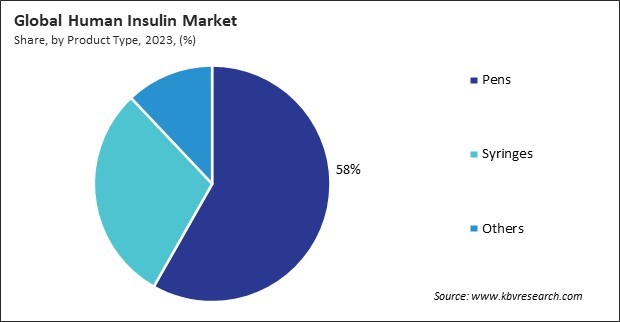“Global Human Insulin Market to reach a market value of USD 20.5 Billion by 2031 growing at a CAGR of 3.2%”
The Global Human Insulin Market size is expected to reach $20.5 billion by 2031, rising at a market growth of 3.2% CAGR during the forecast period.
Germany, France, and the United Kingdom are among the countries in Europe with a substantial diabetic population. These countries have comprehensive healthcare systems that offer extensive support for diabetes management. The availability of advanced insulin products, including analogs and innovative delivery systems, has driven the European market. Consequently, the European region would acquire nearly 31% of the total market share by 2031.

The expansion of the market is being driven by a number of significant causes, one of the most important of which is the worldwide increase in the population of diabetic patients. The development of type 2 diabetes has been facilitated by the environment created by modern lifestyles, which are characterized by a decrease in physical activity and an increase in the ingestion of unhealthy foods. Hence, the increasing prevalence of diabetes, driven by a combination of genetic, demographic, lifestyle, and environmental factors, is a primary driver of the market.
Additionally, Innovations such as insulin pens, pumps, and continuous glucose monitoring (CGM) systems have revolutionized diabetes management, enhancing patient compliance, convenience, and overall quality of life. Continuous glucose monitoring systems represent a leap forward in diabetes management technology. Thus, the continuous evolution of these technologies is a significant driver of growth in the market.
However, Insulin prices have escalated dramatically over the past several decades, far outpacing inflation and wage growth. Even in developed countries, the high cost of insulin presents a formidable challenge. Although health insurance may cover some of the cost, out-of-pocket expenses can still be prohibitively high. Hence, the high cost of insulin is hampering the market's growth.
Moreover, Economic repercussions of the pandemic strained the market. Many individuals faced financial hardships due to job losses and reduced income, which impacted their ability to afford medications, including insulin. With social distancing measures and restrictions on in-person visits, telemedicine became vital for managing diabetes remotely. Thus, the pandemic had an overall negative impact on the market.
On the basis of indication, the market is classified into type 1 diabetes, type 2 diabetes, and gestational diabetes. The type 2 diabetes segment recorded a 40% revenue share in the market in 2023. The prevalence of type 2 diabetes is higher than that of type 1 diabetes, and it is commonly associated with lifestyle variables such as being overweight, deficient in physical activity and having an unhealthy diet.
Based on product type, the market is divided into pens, syringes, and others. The syringes segment procured 30% revenue share in the market in 2023. Affordability is a significant driver, making syringes a viable option for patients in low- and middle-income countries and those without extensive health insurance coverage.

By type of insulin, the market is divided into rapid-acting insulin, short-acting insulin, intermediate-acting insulin, and others. The short-acting insulin segment garnered 23% revenue share in the market in 2023. Short-acting insulins, such as regular insulin, have an onset of action within 30 minutes to an hour and peak in about two to four hours.
Based on distribution channel, the market is segmented into hospital pharmacies, drug stores & retail pharmacies, and online providers. The drug stores & retail pharmacies segment acquired 37% revenue share in the market in 2023. Drug stores and retail pharmacies are accessible and familiar to many patients, providing a convenient option for obtaining insulin and other diabetes-related supplies.
Free Valuable Insights: Global Human Insulin Market size to reach USD 20.5 Billion by 2031
Region-wise, the market is analyzed across North America, Europe, Asia Pacific, and LAMEA. The North America segment recorded 36% revenue share in the market in 2023. The region is home to a significant portion of the global diabetic population, with countries such as the US and Canada experiencing high and rising prevalence rates of diabetes.
| Report Attribute | Details |
|---|---|
| Market size value in 2023 | USD 16.1 Billion |
| Market size forecast in 2031 | USD 20.5 Billion |
| Base Year | 2023 |
| Historical Period | 2020 to 2022 |
| Forecast Period | 2024 to 2031 |
| Revenue Growth Rate | CAGR of 3.2% from 2024 to 2031 |
| Number of Pages | 268 |
| Number of Tables | 449 |
| Report coverage | Market Trends, Revenue Estimation and Forecast, Segmentation Analysis, Regional and Country Breakdown, Porter’s 5 Forces Analysis, Company Profiling, Companies Strategic Developments, SWOT Analysis, Winning Imperatives |
| Segments covered | Indication, Product Type, Type Of Insulin, Distribution Channel, Region |
| Country scope |
|
| Companies Included | MannKind Corporation, Lupin Limited, Sanofi S.A., Novo Nordisk A/S, Eli Lilly And Company, Medtronic PLC, Biocon Limited, Tonghua Dongbao Pharmaceutical Co., Ltd. and Pfizer, Inc. |
By Indication
By Product Type
By Type of Insulin
By Distribution Channel
By Geography
This Market size is expected to reach $20.5 billion by 2031.
Increasing prevalence of diabetes are driving the Market in coming years, however, Substantially high cost of insulin restraints the growth of the Market.
MannKind Corporation, Lupin Limited, Sanofi S.A., Novo Nordisk A/S, Eli Lilly And Company, Medtronic PLC, Biocon Limited, Tonghua Dongbao Pharmaceutical Co., Ltd. and Pfizer, Inc.
The expected CAGR of this Market is 3.2% from 2024 to 2031.
The Type 1 Diabetes segment generated the highest revenue in the Market by Indication in 2023; thereby, achieving a market value of $10.5 billion by 2031.
The North America region dominated the Market by Region in 2023, and would continue to be a dominant market till 2031; thereby, achieving a market value of $7 billion by 2031.
Our team of dedicated experts can provide you with attractive expansion opportunities for your business.

 Drivers
Drivers
 Restraints
Restraints
 Opportunities
Opportunities
 Challenges
Challenges
